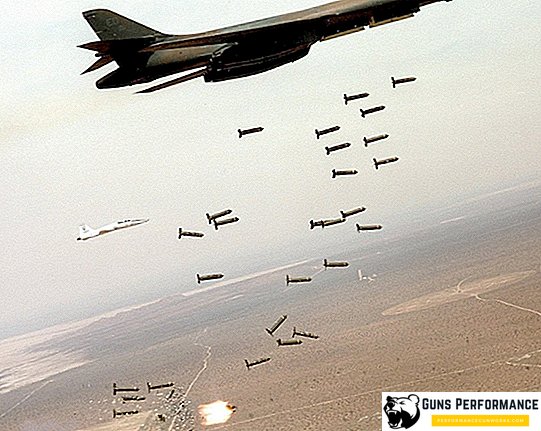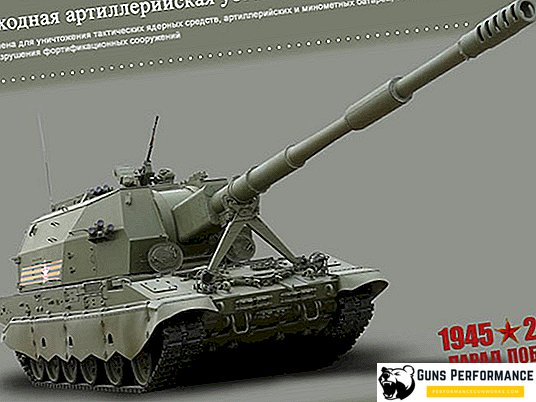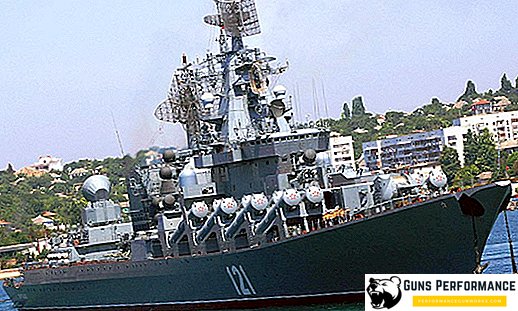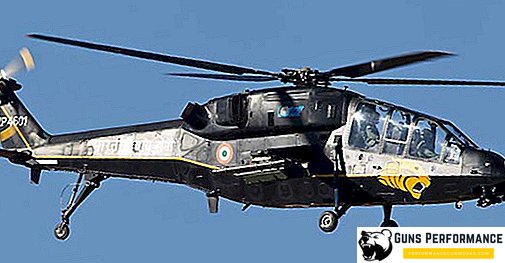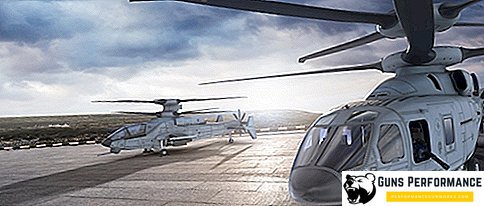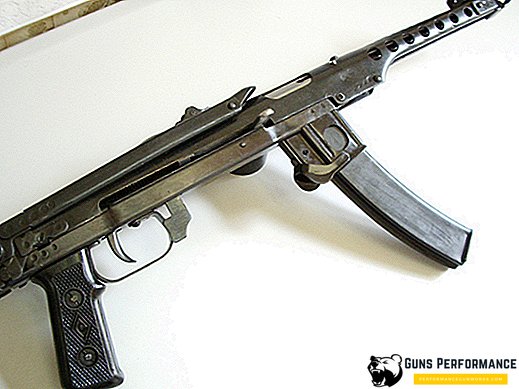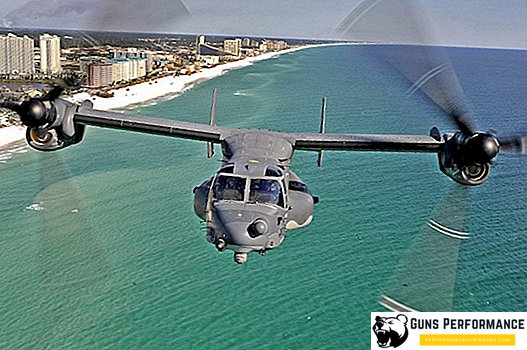
Since the first flight of the Wright brothers, designers from different countries have created a huge number of aircraft, some of which were, to put it mildly, outlandish. Most of these projects remained on paper or did not go beyond the test benches. Therefore, it is doubly interesting to talk about unusual aircraft, which were not only commissioned, but also actively used to perform various tasks.
American tiltrotor (hybrid aircraft and helicopter) Bell V-22 Osprey made its first flight in 1989. The development of "Osprey" involved the company Bell Helicopter and Boeing Rotorcraft Systems. The implementation of the program took about 30 years and tens of billions of dollars. To date, the V-22 Osprey is the only serial tweeter in the world.
"Osprey" can be called the most scandalous project of the American armed forces. Several times he was under threat of closure, various US defense ministers gave orders for the final cessation of funding for the V-22 program. However, each time these decisions were reviewed. Few aircraft have caused so much debate as Osprey.
Disasters that occurred during the operation of the convertible V-22 Osprey, claimed the lives of several dozen people.
Currently, this machine is in service with the US Marine Corps and US special operations forces. Convertible "Osprey" - this is really a unique machine that has no analogues in the world. The cost of one aircraft is 110-120 million dollars (other sources call the amount of 66 million dollars.), All American industry has released more than 200 "Ospreev." During serial production, several versions and modifications of the convertiplane were developed.
The V-22 Osprey is a real engineering marvel, but at the same time this aircraft is the most popular ridicule target in the United States. However, despite the frank harassment, the military command and the majority of experts admit that the Osprey made a real revolution and brought the mobility of American troops to a new level.
Before turning to the review of this aircraft, a few words should be said about the history of its creation.

History of creation
On April 24, 1980, the American special services and the military attempted to free the hostages captured after the Islamic Revolution in Iran. The operation ended in complete disaster: American servicemen died, several planes and helicopters were lost, the hostages were not released, the military operation led to an international scandal.
The plan of the operation was quite simple: the special forces had to land at one of the abandoned air bases near Tehran, enter the city, free the hostages and return home by air.
One of the main reasons for the failure of the Eagle Claw operation was the absence of air vehicles for the US Army, which could fly long distances, carry heavy loads and do without standard runways. To deliver the soldiers and the necessary equipment, C-130 Hercules transport aircraft were used, the seizure of the airfield for which led to the failure of the entire mission.
Helicopters could not be involved in this operation due to insufficient payload and flight range. We needed a new type of aircraft, which would combine the advantages of an airplane and a helicopter: a significant radius of action and the ability to do without airfields.
After some hesitation in 1981 in the USA, a new JVX program began, the purpose of which was to create a convertoplan capable of flying significant distances and making vertical take-off and landing. The project was controlled by a commission consisting of representatives of the armed forces, the Air Force, the Navy and the US Marine Corps. The tender was attended not only by the giants of the American aircraft industry (Bell, Boeing, Lockheed), but also by foreign companies: Aerospatiale and Westland.
Bell has teamed up with Boeing to compete. The Bell company was engaged in rotors, engine nacelles, wings and engines. Boeing experts worked on the creation of the fuselage, cockpit, responsible for avionics and control systems.

The prototype of the convertoplan was ready in May 1988, the first flight took place in March 1989. The tests of the car were difficult, in 1991-1992 two prototypes suffered an accident. There were problems of a different order: land forces left the project, the number of machines ordered was reduced. In the US Congress there was a debate about the complete termination of the project.
However, despite all the difficulties, the implementation of the Osprey project was continued. Flight tests continued until 1999, after which the assembly of pre-production samples began. In 2000, two accidents occurred at once, in which 19 marines were killed. After that, all flights "Ospreev" were discontinued for a year and a half. They were renewed only in 2002.
During this period, the developers have done a huge amount of work on the modernization of the machine and the elimination of detected defects. And they had enough. The car was so revolutionary that the designers had to deal with problems that they did not even suspect. One of the main was the so-called "vortex ring" effect.
This phenomenon was known earlier, in helicopters. It was observed in vehicles that landed at a low translational speed, but with a significant vertical. In this case, the rotor blades fell into the vortex flow, previously created by the rotor. The lifting force fell sharply, which often resulted in the fall of the machine.
For the "Osprey", which can not land "on an airplane", this problem was particularly acute. In addition, the tiltrotor lift force can sharply decrease only for one of the engines, then it will simply tip over.
After a disaster, the convertoplan creation program was carefully analyzed. The Americans came to the conclusion that creating a new aircraft instead of the Osprey would be even more expensive, so they decided to throw all their strength on finalizing this machine. Additional studies on the effect of the "vortex ring" were carried out, NASA experts were involved. More than a hundred changes were made to the design of the convertoplane, mainly they related to the nacelle. The software has also been seriously modified.

Operational tests continued until 2005, only then did the Pentagon recognize the convertoplan safe for use.
In 2008, a contract was signed for the supply of 167 Ospreevs, its amount was $ 10.4 billion. In total, up to 2014, 200 convertiplanes were released, most of which are in service with the USMC.
Official representatives of the US military department have repeatedly stated the possibility of supplying the Osprey to the allied states: Canada, South Korea, Japan, Israel and the United Arab Emirates.
Accidents and disasters did not stop pursuing the tiltrotor, even after its substantial revision and adoption into service. Between 2010 and 2018, seven serious incidents occurred, which resulted in eight deaths, and a few dozen others were injured. Accidents occurred both in the United States and abroad.
Modifications
Currently, there are several modifications of the convertible V-22 Osprey:
- CV-22B. This is a modification designed for US Special Operations Forces (US SOCOM). It has an increased flight range (due to additional tanks) and is equipped with some other special equipment.
- MV-22B. A modified convertoplane designed for the United States Marine Corps. It was the marines throughout the existence of the program were its main lobbyists. This option "Osprey" can take on board up to 32 paratroopers, able to take off and sit on the ship's deck.
- CMV-22B. Modification designed to provide transportation. It has additional fuel tanks.
- EV-22. Convertoplane designed for radio detection and guidance. Developed for the British Navy.
- HV-22. Search and rescue convertoplane, which was created by order of the US Navy.
- SV-22. A modification designed to combat submarines.

Description of construction
V-22 Osprey is the world's first convertoplane, which is launched into mass production. This aircraft has two engines that can change the thrust vector, from horizontal to vertical. According to the classification of the American aviation classification, Osprey is a vertical take-off and landing aircraft.
Convertible planes can take off and land vertically (like helicopters), but they are capable of a long horizontal flight at high speed (like airplanes).
Osprey is made according to the normal aerodynamic scheme, it is a high-flight with two gas-turbine engines (GTE) and two-tail tail unit. Composite materials (about 40%) were actively used in the airframe design, which allowed developers to significantly reduce the aircraft mass (by almost a ton) and reduce its cost. Also, Osprey propeller blades are made of composite materials.
All modifications of the convertoplane have the same airframe, they differ only in the volume of fuel tanks, the composition of electronic equipment and weapons.

The fuselage of the convertoplane is of semi-monocoque type, with a rectangular cross section. The side fairings of the fuselage are used to clean the main landing gear, accommodate additional fuel tanks and some equipment of the convertoplane. In front of the fuselage is the cockpit, in which armored ejection seats are installed. Each of them is able to protect a person from being hit by a 12.7 mm bullet. The crew of the Osprey consists of three or four people.
Most of the fuselage of the convertoplane is occupied by the cargo-passenger compartment, on the right side of the machine there is a two-section door equipped with a ladder.
The wing of the convertoplan is of a caisson type with two spars, it has a small angle of reverse sweep and is almost entirely made of composite materials. Mechanization wing convertoplan consists of four elevons.

The wing is located on a circular support that allows you to rotate it and place along the fuselage to reduce the size of the aircraft.
The power plant of the convertoplan consists of two Rolls-Royce AE 1107C engines located in swiveling nacelles at the ends of the wing. The engines connect to each other through the wing, which allows one of them to make a controlled descent.
Each engine has a modular design, it is equipped with a digital control system FADEC, which significantly increases the reliability of its work. In addition, the power plant "Osprey" has a cooling system for exhaust gases, and the hottest engine parts are shielded. This reduces the visibility of the aircraft in the infrared range.
In each nacelle there are two gearboxes: one transmits engine power to the screw, and the second drives the synchronization shaft passing through the center-section of the Osprey. The screws have three trapezoidal blades, elastomer bearings are used in their hinges. Rotation of the nacelles is done using a hydraulic drive.
The transition from vertical to horizontal flight takes about 12 seconds. During vertical flight, the control occurs by changing the screw pitch and engine thrust. After the vehicle has reached a speed of 180-200 km / h, the lifting force is already provided by aerodynamic surfaces, and the engine nacelles are transferred to a horizontal position.
"Osprey" has a two-fin vertical tail, almost entirely made of composite materials. Its area is 12.45 square meters. meters
Chassis tiltrotor tricycle retractable. The nose rack is retracted back to the special compartment of the fuselage, the side racks during the flight are placed in the sponsons of the hull.
The fuel system of the aircraft consists of several groups of fuel tanks, which are located in the wing consoles and fuselage sponsons. In the cargo compartment can be placed additional tanks. It should be noted that the capacity of tanks "spetsnaz" modification "Osprey" is much larger than the version of the aircraft, designed for marines. All fuel tanks are protected, which provides protection against fuel leakage if 12.7 mm ammunition is dropped or dropped from a height of 20 meters. Also, "Osprey" has a system of pumping fuel tanks with an inert gas.
Osprey has a rather complicated fuel supply system: the engines consume it from the supply tanks into which it is injected from the main tanks (and in strict sequence). All fuel supply processes are automated. Convertoplane can refuel and in flight: the refueling unit is located in the nose of the fuselage.
The structure of the onboard radio-electronic equipment "Osprey" includes an inertial navigation system, a radio compass, an altimeter, and a radio system for landing the aircraft. The cockpit has four multifunctional displays and a screen that displays general information: maps, videos, and various images.

The control of the aircraft is carried out using EDSU and hydraulic systems.
During the design and further work on the improvement of the Osprey, much attention was paid to ensuring the safety of the crew and passengers in case of accidents or damage to the convertoplane. All important systems of the machine are spaced and duplicated if possible. Passengers and crew members have armored seats. Blades of screws are made of highly durable composite materials.
Gearboxes and engines as far as possible from the pilots and paratroopers. The tiltrotor chassis completely absorbs the impact impulse when colliding with the ground at a speed of 30 km / h, the cockpit design is enhanced. In the case of a splashdown, the fuselage maintains buoyancy for 10 minutes, which is quite enough to evacuate pilots and passengers.

Project Evaluation
"Osprey" - this is a very controversial machine, which today causes a huge amount of controversy and complaints. However, it is impossible to deny the fact that the developers managed to implement the concept that was laid at the start of the program. They made an aircraft that can take off vertically and travel considerable distances at the speed of an ordinary aircraft.
But what was the cost of this project of the American army! Almost thirty years of development and testing, billions of dollars and dozens of pilots and paratroopers who died in accidents and catastrophes. Most experts believe that the cost of the V-22 program has exceeded $ 50 billion. Many complaints are the reliability of these machines. In 2007, the influential American edition of Time called Osprey a “flying disgrace” and placed his photo with such a signature on the cover.

In addition, Osprey is quite expensive and difficult to operate. During the use of convertible planes in Afghanistan, their engine life was only 200 hours (it is several times longer for the CH-53 Sea Knight helicopter). At the beginning of the operation of "Ospreev", the airfield crews had certain difficulties with the maintenance of these vehicles.
On the other hand, the speed and capacity of convertiplanes largely overlap their main disadvantages. Osprey really turned out to be very expensive, but it proved to be so useful that the military did not want to abandon this car. After taking "Osprey" in operation, most of its shortcomings were eliminated or, at least, significantly stopped. The accident of the convertoplane is at a rather low level (some authors generally call Osprey the safest aircraft).
In recent years, information has emerged about the development of the new convertible Hop Bell V-280 Valor, which is occupied by Bell Helicopter and Lockheed Martin. It was officially introduced in 2013, the first flight of the machine is to be held in 2018.

Specifications
| Type of | multipurpose convertoplane |
| Power point | two Rolls-Royce T406 on 6150 l. with. each |
| Payload | 3 or 4 pilots and 24 paratroopers; up to 5.5 tons of cargo |
| Practical ceiling, m | 7620 |
| Practical range, km | 2627 |
| Maximum take-off weight, t | 27,4 |
| Cruising speed, km / h | 510 |
| Wingspan (at the ends of the screws), m | 25,78 |
| Length m | 19,23 |
| Height (by keel), m | 5,28 |


